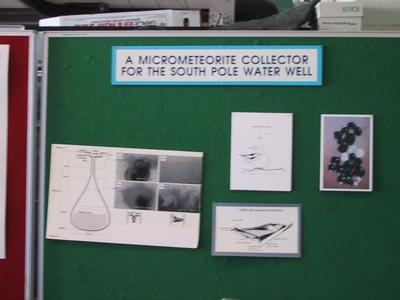8 August, 2001
Micrometeorites
My Antarctic adventure is beginning far from Antarctica. It has started at The Cold Regions Research and Engineering Laboratory (CRREL). Located in Hanover, New Hampshire, home to Dartmouth College, Hanover typifies the classic image of a small northeastern town. Old brick and lush foliage dominate the landscape. Although it is downright hot today, the local residents seem to enjoy discussing the abundance of snow they receive every winter.
Although I'm unfamiliar with this research facility, it turns out several scientists are exploring areas of interest to me. I mentioned my interest in meteorites to Arlyn Bruccoli, a coordinator of the Teachers Experiencing the Antarctic (TEA). She presented me with a unique opportunity today when she set up a lunchtime meeting for me with Dr. Susan Taylor, a meteoriticist here at CRREL. A former roommate of mine once said, "Opportunity is not a lengthy visitor." How true.
A meteoriticist studies the objects of my obsession, meteorites. I can't say how many times I've mentioned to someone that I'm a meteorite enthusiast only to hear them reply, "So...you're a meteorologist?"
Dr. Taylor actually studies a frequently overlooked area of meteorite science, the study of micrometeorites. What are they? They are more than just "little meteorites." They are dust-sized fragments of asteroids and comets. What really distinguishes them is the fact that their chemistry differs so much from their larger counterparts.
According to Dr. Taylor, the heating they experience upon atmospheric entry causes some of the more volatile elements to vaporize. This leaves the rest of the parcticle altered when it lands softly on the ice. Over hundreds of years, the parcticle becomes covered by snow and eventually buried in glacial ice. Just below the South Pole station lays the water well for the station. As it melts down into the glacier, these micrometeorites accumulate in the bottom of the well. Using a suction device developed by her husband, Dr. Taylor removes the micrometeorites from the well and collects them for later analysis.
The major application of this study is the search for IDP's (Interplanetary Dust Parcticles). It is thought that these parcticles may be the remnant of the disk-shaped dust cloud from which our solar system formed. Studying their chemistry reveals clues as to the temperature and rate at which our solar system formed.
Dr. Taylor hopes to return this year to collect new micrometeorites. With the discovery of extra-solar systems, she hopes to provide information that will be helpful in modeling the process of solar system formation.

Posters of micrometeorite research.
Contact the TEA in the field at
.
If you cannot connect through your browser, copy the
TEA's e-mail address in the "To:" line of
your favorite e-mail package.
|
